The pearl gourami is a popular aquarium fish known for its striking beauty and unique appearance. As part of the Osphronemidae family, this species requires specific tank conditions to thrive. In this text, you’ll discover the ideal water parameters for keeping pearl gouramis, the best feeding practices, suitable tank mates, and tips for successful breeding. By understanding these aspects, both beginners and experienced aquarists can create a suitable environment for this captivating fish.
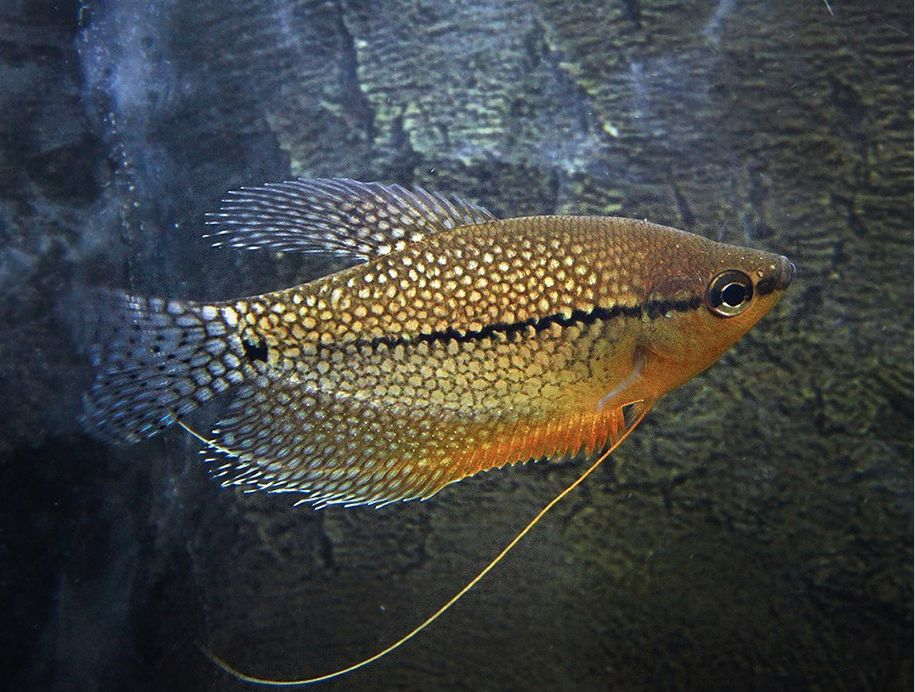
Contents
Habitat in the wild
The pearl gourami is a captivating freshwater fish from the Osphronemidae family, renowned for its vibrant colors and peaceful nature. This species is particularly admired for its stunning pearly iridescent scales that shimmer under aquarium lighting, making it a favorite among enthusiasts. Native to Southeast Asia, pearl gouramis thrive in shallow, warm waters rich in vegetation, such as small lakes, bogs, and slow river backwaters. These habitats often feature muddy bottoms covered with a layer of fallen leaves, providing both shelter and food sources. In the wild, water parameters typically range from a pH of 6.0 to 8.0, hardness of 5 to 19°dH, and temperatures between 22 to 28 °C (72–82 °F).
Despite their beauty, pearl gourami populations are facing challenges due to habitat loss from swamp reclamation efforts in central Thailand and peninsular Malaysia. As their natural environments diminish, these fish have been classified as “Near Threatened.” This decline highlights the importance of habitat conservation efforts. However, the aquarium trade remains stable, thanks to successful mass breeding programs established in both Europe and the United States. These programs ensure that pearl gouramis remain accessible to aquarists, allowing hobbyists to enjoy their beauty without depleting wild populations. For more detailed information about the conservation status and biology of pearl gouramis, you can refer to FishBase.
Additionally, pearl gouramis have a unique courtship behavior that involves males building bubble nests to attract females. During breeding, males perform elaborate displays to showcase their colors and strength, and they are known to care for the eggs and fry. In captivity, these fish can live for several years, often reaching 4-5 years with proper care, and can even learn to recognize their owners, creating a more interactive aquarium experience.
Description
Lifespan
The average lifespan of pearl gouramis typically ranges from 4 to 6 years when kept in a well-maintained aquarium with proper care. However, with exceptional care, some individuals may live up to 8 years or more. Factors influencing their lifespan include genetics, diet, water quality, stress levels, and overall living conditions. To maximize their lifespan, it is essential to provide a suitable environment, balanced nutrition, and a stress-free atmosphere. Regular water changes and monitoring for any signs of illness or distress significantly contribute to their long-term health and well-being. Moreover, maintaining stable water parameters and providing enrichment in their habitat can enhance their quality of life, leading to potentially longer lifespans.
Size
Male pearl gouramis can grow up to 12 centimeters (4.7 inches) long, while females are typically slightly smaller. In a home aquarium, their size generally does not exceed 8 to 10 centimeters. Like many fish species, size can vary depending on environmental factors, diet, and the level of care provided. Ensuring a spacious tank with appropriate filtration and water quality is crucial for allowing these fish to reach their full growth potential. Larger tanks also enable better social interactions, which are vital for their well-being.
Body
The body of the pearl gourami is oval-shaped, elongated, and flattened on the sides, with a pointed snout and a small mouth. These fish possess well-developed fins, with the anal fin being particularly large, while the dorsal fin is shorter. Their abdominal fins are thin and filament-like, serving as tactile organs that help them navigate their environment. This unique body structure allows pearl gouramis to maneuver gracefully through dense vegetation in their natural habitats.
Color
The pearl gourami derives its name from the distinctive tessellated pattern of spots that resemble small pearls. Their coloration is a striking silvery lilac, adorned with pearlescent spots that cover nearly the entire body, including the anal, dorsal, and tail fins, except for the head. A prominent black dash line extends from the nose to the beginning of the tail fin, becoming less pronounced toward the tail. The back of the fish is typically brownish, adding to its overall visual appeal. This vibrant coloration not only enhances their beauty in aquariums but also plays a role in communication and mating displays.
Labyrinth Organ
Like other members of the Trichopodus species, pearl gouramis possess a labyrinth organ, allowing them to absorb atmospheric oxygen directly from the air when they surface. This fascinating adaptation involves a complex system of channels located within the mandibular arch dilatation, lined with tiny bony lamellae covered in a mucous membrane rich in blood vessels. When the fish gasps air at the surface, oxygen is transferred into their bloodstream. This organ enables pearl gouramis to survive in low-oxygen environments or even out of water for extended periods. The labyrinth organ begins to develop just 2 to 3 weeks after the larvae hatch from their eggs.
While pearl gouramis do have gills, these serve only an auxiliary function. If deprived of access to the water surface for too long, they will suffocate. This unique breathing mechanism contributed to early challenges in transporting pearl gouramis to Europe in the 19th century. Many fish died during transit because they were placed in barrels filled to capacity, denying them access to atmospheric air. Observations of their natural behavior eventually led to successful transportation methods, where barrels were filled only two-thirds full of water, allowing the fish to breathe at the surface. This insight facilitated the transport of thousands of pearl gouramis without loss, making them more accessible to aquarists worldwide.
| Characteristic | Description |
|---|---|
| Scientific Name | Trichogaster leeri |
| Common Name | Pearl Gourami |
| Family | Osphronemidae (Gourami family) |
| Origin | Southeast Asia: Thailand, Malaysia, Indonesia |
| Habitat | Slow-moving or still waters, densely vegetated with aquatic plants (lakes, ponds, slow rivers) |
| Maximum Size | 4 to 5 inches (10 to 12 cm) |
| Lifespan | 4 to 6 years (with proper care) |
| Temperament | Generally peaceful, may display territorial behavior |
| Water Parameters | Temperature: 75°F to 82°F (24°C to 28°C) |
| pH: 6.0 to 7.5 | |
| Water hardness: Soft to slightly acidic | |
| Diet | Omnivorous: flakes, pellets, live/frozen foods (brine shrimp, daphnia, bloodworms), veggie matter |
| Color | Pearl-like iridescent scales (silver/white). With hints of pink, blue, and green |
| Breeding | Bubble nest builder, paternal mouthbrooder |
| Compatibility | Generally peaceful, but avoid aggressive tankmates |
| Tank Size | Minimum 20 gallons (75 liters) for a pair |
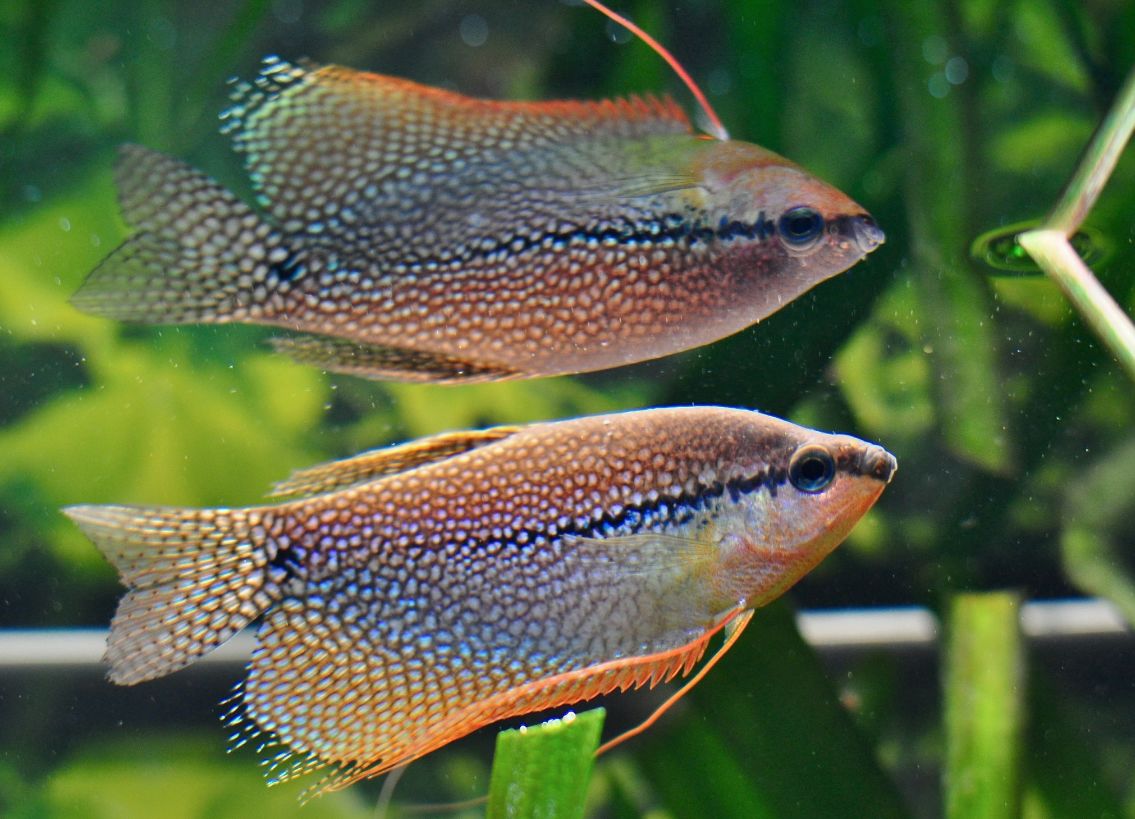
Difficulties in keeping
The pearl gourami is a rather demanding fish, so it can’t be recommended for beginning aquarists. Of all gourami species, the pearl gourami is the most demanding one. The fish is very timid and more sensitive to temperature change or water contamination than opaline gourami.
Therefore if you are just taking a shot at aquarium husbandry, it’s better to choose some other fish. For example, a betta fish. However, nothing special is required to keep the fish. You just have to create proper tank conditions and have some experience.
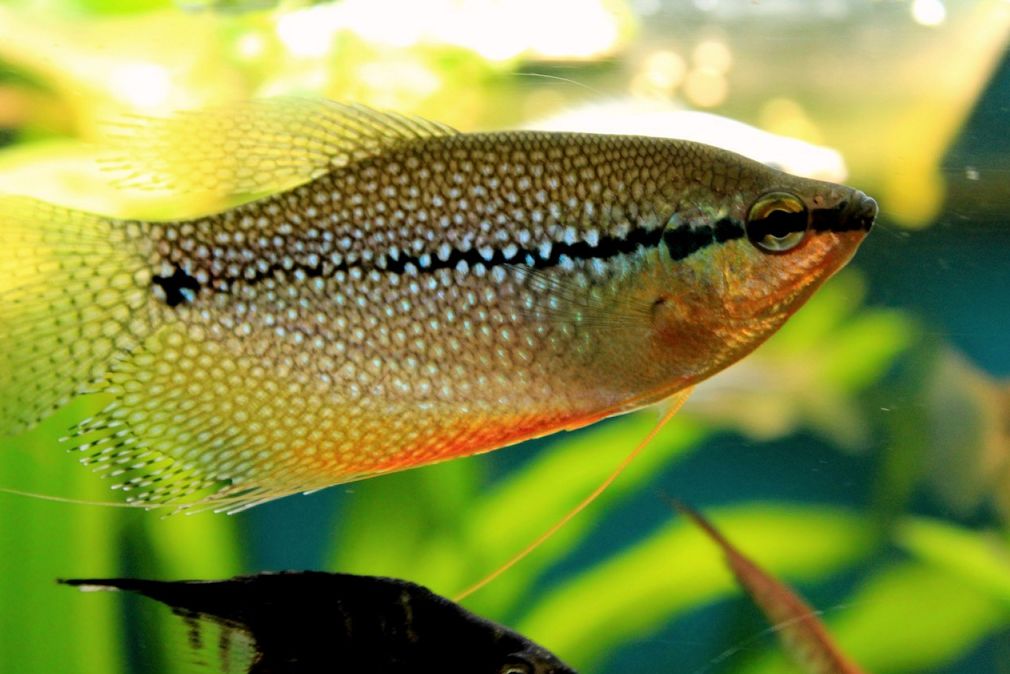
Care and keeping in a tank
Tank Size
The recommended tank size for pearl gouramis varies based on factors such as the number of fish and whether they will be kept in a community tank. While pearl gouramis are generally peaceful, they can become territorial, particularly during breeding or when confined in small spaces. For a single pearl gourami or a pair (one male and one female), a minimum tank size of 20 gallons (approximately 75 liters) is ideal. If you opt for a smaller tank, be sure to reduce the number of fish accordingly. Additionally, having more females than males can help mitigate competitive behavior among males.
For those looking to maintain a small community tank with other peaceful species, a larger setup is advisable. A 30-gallon (approximately 113 liters) tank or larger provides sufficient space for a small group of pearl gouramis and helps accommodate their social dynamics. Larger tanks also allow for the creation of more natural environments with ample hiding spots and aquatic plants, which can significantly reduce stress and enhance their well-being. Proper tank size not only supports their health but also fosters more natural behaviors, such as foraging and exploring.
Water Parameters
Pearl gouramis do not have overly strict water composition requirements, but they thrive best in soft, aged water (up to 15 °dH) that is slightly acidic to neutral (pH 6.0–7.0). Maintaining a clean tank is crucial, as these fish are sensitive to fungal infections and other diseases. The following water parameters are ideal for pearl gouramis:
- Temperature: 75°F to 82°F (24°C to 28°C). This tropical fish prefers a stable environment, so using a reliable aquarium heater is essential to maintain consistent water temperatures.
- pH Level: 6.0 to 7.0. Regular testing of the pH level is important; adjustments should be made gradually to avoid stressing the fish.
- Water Hardness: Soft to slightly hard, ideally between 5 to 15 dGH. A moderate hardness level promotes their overall health.
- Ammonia, Nitrite, and Nitrate Levels: Both ammonia and nitrite levels should remain at zero, as they are toxic to fish. Regular water testing and changes are crucial to maintaining low nitrate levels, ideally below 20 ppm.
Tank Setup: Decorations and Plants
To ensure the pearl gourami remains healthy, it is vital to maintain a well-ventilated and warm air layer near the water’s surface. A tank lid is essential, as it prevents debris from falling in and maintains a humid microclimate that supports the health of the labyrinth organ. Since pearl gouramis are timid, a densely planted tank is ideal. Incorporate plants with strong root systems along the back and sides of the tank, along with floating plants that provide shade and security. While the substrate type is less critical, a dark background can enhance the fish’s vibrant colors, creating a more visually appealing environment.
Filtration
Water filtration is important for maintaining cleanliness, but it should be gentle to avoid creating excessive water flow, as pearl gouramis prefer slow-moving waters. An efficient filtration system will keep harmful substances at bay, but it is equally important to regularly clean the filter media to ensure optimal function. Additionally, conducting regular water changes of about 20–30% every 1–2 weeks will help maintain excellent water quality, supporting the health and longevity of these beautiful fish.
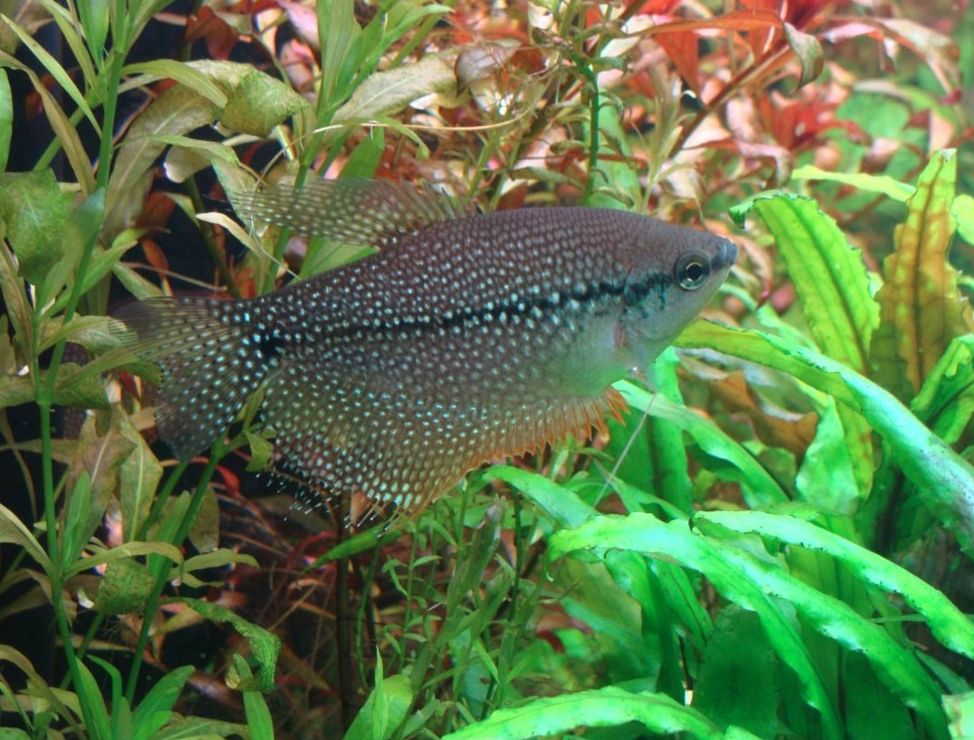
Diet
The pearl gourami is an omnivorous fish with a diverse diet. In its natural habitat, it consumes a variety of foods, including insects, larvae, and zooplankton. This adaptability continues in captivity, where the pearl gourami will eagerly accept various types of food, including live, frozen, and artificial options. A well-rounded diet can be established using high-quality flakes and pellets as a base, supplemented with live or frozen foods such as bloodworms, tubifex, and brine shrimp. This combination not only meets their nutritional needs but also promotes their vibrant coloration and overall health.
One notable advantage of using artificial food is its high digestibility, which can significantly reduce the amount of waste produced by the fish, thereby helping maintain cleaner tank water. However, it is essential to consider the small size of the pearl gourami’s mouth, which limits its ability to consume larger food items. Additionally, these fish are not particularly aggressive feeders, so monitoring their feeding is crucial to ensure they receive adequate nutrition.
Feeding pearl gouramis several times a day in small portions is advisable, with the expectation that all food should be consumed within a few minutes to prevent spoilage and maintain water quality.
An intriguing characteristic of the pearl gourami is its ability to consume hydra, a small coelenterate known for its poisonous tentacles. While hydra can pose a threat to fish and their fry in a tank, pearl gouramis can help manage this unwanted presence. By incorporating them into your aquarium, you not only add beauty and grace but also introduce a natural predator that can help control hydra populations, contributing to a healthier aquatic environment.
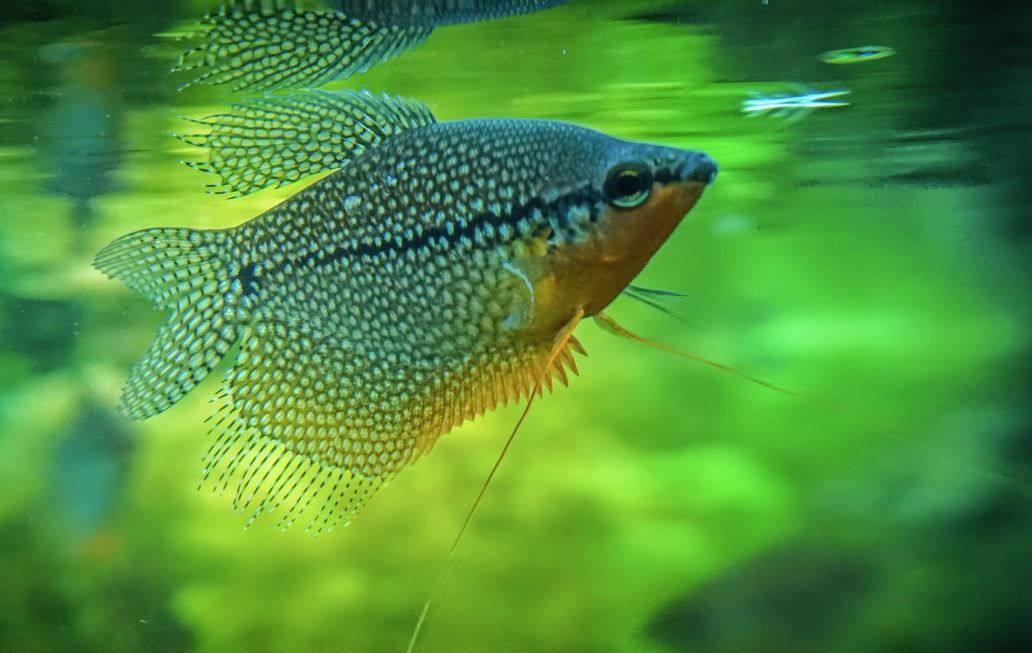
Tank mates
Pearl gourami swims slowly and creates a calm atmosphere in a tank. The fish has a peaceful, timid temper and gets on well with its tank mates. You can’t keep the fish together with active or aggressive fish species.
This is the most peaceful gourami species and will not eat small fish, making it a perfect dweller of a not very crowded community tank. At that, since the pearl gourami is timid, it may hide till it makes itself at home.
The best tank mates for pearl gourami are fishes of equal size and behavior. It’s better to keep this gourami species together with dwarf gouramis or honey gouramis. But keep in mind that other gourami species (like opaline gourami or paradise fish) may demonstrate aggression towards its kind. You can also keep it with betta fish, but they have unpredictable and quarrelsome behavior and are quite capable of haunting timid pearl gourami. Therefore it’s better to avoid such tank mates.
Although its intraspecific bellicosity angelfish will be a good tank mate for pearl gourami, the fish shows good compatibility with neon tetra, guppies, harlequin rasbora, bolivian ram, and other small fishes.
You can also keep this gourami with shrimps, but only with large ones (like Amano shrimp) because the fish will treat small cherry shrimp as food. Gourami won’t eat a lot of shrimps, but if you need them in a tank, then it’s better not to keep these together in one tank.
Gender differences: male vs female
To differentiate between male and female pearl gouramis, several key characteristics can be observed. Males typically exhibit a larger and more elongated body shape, making them noticeably stronger and slimmer than females. Their dorsal fin is pointed and elongated, complementing their vibrant coloration. The throat, chest, and abdominal fins of male pearl gouramis often showcase striking orange or even red hues, especially during the spawning period, when excitement enhances these colors. Additionally, males may display vertical stripes that become more pronounced during courtship or territorial displays.
In contrast, female pearl gouramis have a more rounded dorsal fin that is shorter than that of males. Their coloration tends to be less intense, featuring more subdued colors and patterns. Mature females may also exhibit a slightly rounded abdomen, particularly when they are carrying eggs. While these characteristics can help in identification, they are not always entirely reliable, especially in younger or stressed individuals. Observing behavior during breeding conditions can provide further clues, as males are generally more colorful and display more pronounced behaviors when competing for mates. Consulting with an experienced aquarist or knowledgeable fish store expert can also aid in accurately determining the sex of your pearl gouramis.
Breeding
Breeding pearl gouramis is a more challenging process compared to other gourami species. To facilitate successful breeding, a tank of at least 30 liters is necessary, but considering the high fertility of pearl gouramis, a tank of 50 to 60 liters is recommended. The water level should not exceed 25 to 35 centimeters, allowing ample space for the fish to maneuver.
The water should be aged and soft, with a hardness of up to 7°dH and a pH around 7.0. Maintaining a water temperature between 27 and 32 °C is crucial for encouraging spawning behavior. The breeding tank should be decorated similarly to their main tank, incorporating plenty of plants, with riccia being an excellent choice due to its dense growth that provides both shelter and a natural spawning substrate.
Creating a peaceful environment is essential, so placing the breeding tank in a quiet location and covering the glass walls can help reduce stress. Breeding occurs in pairs, and it is advisable to select young fish, starting from about 8 months old, that exhibit bright coloration. To prepare for spawning, keep the male and female separated for a week while providing them with a nutritious diet of live food to enhance their readiness.
Introduce the male to the spawning tank first, allowing him to acclimate, and then add the female a few hours later. To stimulate spawning, perform a partial water change of 1/5 to 1/3 of the tank’s water and raise the temperature by 2 to 3 °C. During this time, it’s best to refrain from feeding the fish; start again with small portions of well-washed bloodworms or tubifex after two days.
As spawning approaches, the male becomes more assertive, so it’s important to provide the female with hiding spots. The male will construct a bubble nest using air bubbles, plant material, and his saliva at the water’s surface. This nest is typically low and expansive, although spawning can sometimes occur without a nest. Generally, spawning happens on the second day after the pair has been placed in the tank and lasts about two hours, with the fish laying eggs in batches. The male gently turns the female upside down to facilitate egg-laying beneath the nest.
Pearl gourami eggs possess a fatty coating that causes them to float to the surface immediately after being laid. The male collects the eggs and places them into the nest, typically producing between 600 and 700 eggs at a time, though the total can reach up to 2000.
Once spawning is complete, the female should be removed from the tank, leaving the male to care for the eggs. He diligently tends to the nest, ensuring the eggs are secure and properly arranged. The eggs will hatch in about 1 to 2 days, releasing very small larvae that are equipped with a yolk sac that sustains them for 2 to 4 days. After this period, the larvae develop into juveniles and begin swimming independently, at which point the male can be removed from the breeding tank.
Lower the water level to about 6 to 10 centimeters and maintain this level for around a month until the young fish begin using their labyrinth organ to gulp air from the water’s surface. Initially, juveniles are very tiny and can be fed infusoria for the first 5 to 6 days, gradually introducing zooplankton into their diet. If there is a high number of juveniles, some aeration is beneficial to maintain water quality.
Maintaining a clean tank is crucial for the health of the young fish. Pearl gouramis can spawn 3 to 4 times during a season, and they remain reproductively viable for up to 5 years, allowing for multiple breeding opportunities throughout their lifespan.